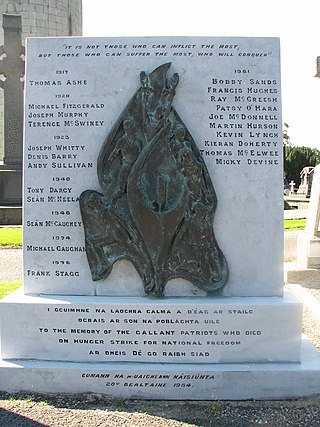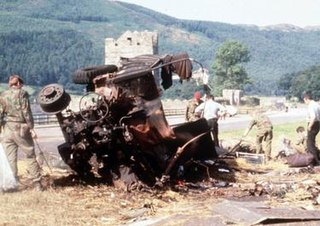
The East Tyrone Brigade of the Provisional Irish Republican Army (IRA), also known as the Tyrone/Monaghan Brigade was one of the most active republican paramilitary groups in Northern Ireland during "the Troubles". It is believed to have drawn its membership from across the eastern side of County Tyrone as well as north County Monaghan and south County Londonderry.

Camlough is a village west of Newry in County Armagh, Northern Ireland. The village is named after a lake, known as the Cam Lough. South of the village is Camlough Mountain, part of the Ring of Gullion and is designated an Area of Outstanding Natural Beauty. Camlough had a population of 1,074 at the 2011 Census.

Raymond McCreesh was an Irish volunteer in the South Armagh Brigade of the Provisional Irish Republican Army (IRA). In 1976, he and two other IRA volunteers were captured while attempting to ambush a British Army observation post. McCreesh was one of the ten Irish republicans who died during the 1981 Irish hunger strike in the Maze Prison. McCreesh was one of 22 Irish republicans who died on hunger-strike.
This is a chronology of activities by the Provisional Irish Republican Army (IRA) from 1970 to 1979.

The South Armagh Brigade of the Provisional Irish Republican Army (IRA) operated during the Troubles in south County Armagh. It was organised into two battalions, one around Jonesborough and another around Crossmaglen. By the 1990s, the South Armagh Brigade was thought to consist of about 40 members, roughly half of them living south of the border. It has allegedly been commanded since the 1970s by Thomas 'Slab' Murphy who is also alleged to be a member of the IRA's Army Council. Compared to other brigades, the South Armagh IRA was seen as an 'independent republic' within the republican movement, retaining a battalion organizational structure and not adopting the cell structure the rest of the IRA was forced to adopt after repeated intelligence failures.

The Warrenpoint ambush, also known as the Narrow Water ambush, the Warrenpoint massacre or the Narrow Water massacre, was a guerrilla attack by the Provisional Irish Republican Army (IRA) on 27 August 1979. The IRA's South Armagh Brigade ambushed a British Army convoy with two large roadside bombs at Narrow Water Castle outside Warrenpoint, Northern Ireland. The first bomb was aimed at the convoy itself, and the second targeted the incoming reinforcements and the incident command point (ICP) set up to deal with the incident. IRA volunteers hidden in nearby woodland also allegedly fired on the troops, who returned fire. The castle is on the banks of the Newry River, which marks the border between Northern Ireland and the Republic of Ireland.
The Troubles in Bessbrook recounts incidents during and the effects of the Troubles in Bessbrook, County Armagh, Northern Ireland.
The Ballygawley bus bombing was a roadside bomb attack by the Provisional Irish Republican Army (IRA) on a bus carrying British soldiers in Northern Ireland. It occurred in the early hours of 20 August 1988 in the townland of Curr near Ballygawley, County Tyrone. The attack killed eight soldiers and wounded 28. In the wake of the bombing, the British Army began ferrying its troops in and out of County Tyrone by helicopter.
This is the Timeline of Irish National Liberation Army actions, an Irish republican socialist paramilitary group. Most of these actions took place as part of its 1975–1998 campaign during "the Troubles" in Northern Ireland. The INLA did not start claiming responsibility for its actions under the INLA name until January 1976 at which point they had already killed 12 people, before then they used the names People's Liberation Army (PLA) and People's Republican Army (PRA) to claim its attacks.
This is a chronology of activities by the Provisional Irish Republican Army (IRA) from 1980 to 1989. For actions before and after this period see Chronology of Provisional Irish Republican Army actions.
This is a chronology of activities by the Provisional Irish Republican Army (IRA), from 1992 to 1999.

From 6 to 11 July 1997 there were mass protests, fierce riots and gun battles in Irish nationalist districts of Northern Ireland. Irish nationalists/republicans, in some cases supported by the Provisional Irish Republican Army (IRA), attacked the Royal Ulster Constabulary (RUC) and British Army. The protests and violence were sparked by the decision to allow the Orange Order to march their traditional route, passing through a Catholic/nationalist neighbourhood of Portadown. Irish nationalists were outraged by the decision and by the RUC's aggressive treatment of those protesting against the march. There had been a bitter dispute over the march for many years.

In the Ballygawley land mine attack of 13 July 1983, four soldiers of the British Army's Ulster Defence Regiment (UDR) were killed by a Provisional Irish Republican Army (IRA) land mine near Ballygawley in County Tyrone, Northern Ireland. The soldiers were travelling in a convoy of armoured vehicles when the land mine was detonated remotely.
On 9 April 1990, the South Down Brigade of the Provisional Irish Republican Army (IRA) detonated a massive improvised land mine under a British Army convoy outside Downpatrick, County Down, Northern Ireland. Four soldiers of the Ulster Defence Regiment (UDR) were killed, the regiment's greatest loss of life since 1983.
In the Dungannon land mine attack of 16 December 1979, the Provisional Irish Republican Army (IRA) ambushed two British Army Land Rovers with an improvised land mine outside Dungannon, County Tyrone, Northern Ireland. Four British soldiers were killed in the attack.
On 17 July 1975 the South Armagh Brigade of the Provisional Irish Republican Army (IRA) detonated an improvised bomb inside a beer keg when it was being investigated by British Army soldiers. Four soldiers were killed and another seriously injured. This was the first major breach in the truce negotiated by the IRA and British government in February 1975. The attack took place in Forkhill, County Armagh. It was one of many such attacks by the IRA in the 1970s.

Throughout the protracted conflict in Northern Ireland (1960s-1998), the Provisional IRA developed a series of improvised mortars to attack British Army and Royal Ulster Constabulary (RUC) security bases. The organisation also purchased both light and heavy machine guns in order to hamper the British Army supply of border bases by helicopter. The IRA fitted vehicles, specially vans and trucks, with both types of weapons. Vans, trucks and tractors were modified to transport concealed improvised mortars to a launch area near the intended target and fire them, while light and heavy trucks were employed as firing platforms mounting machine guns, particularly M60s and DShKs. Improvised armoured vehicles and heavy equipment were also used to penetrate the perimeter of fortified security bases. The IRA vehicles were often disguised as belonging to civilian companies or even government agencies.
On 24 June 1972, in the rural townland of Crabarkey near Dungiven, the Provisional IRA detonated an improvised land mine, killing three British Army soldiers in a Land Rover. It was one of many such landmine attacks by the IRA in rural areas in the 1970s.
On 10 September 1972, an active service unit (ASU) of the Provisional IRA's East Tyrone Brigade carried out a landmine attack against a British Army mobile patrol, along a small road in the rural village of Sanaghanroe near the town of Dungannon in County Tyrone.








